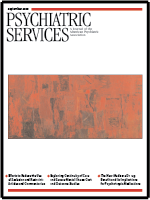September 2005: This Month's Highlights
Special Section on Seclusion and Restraint
This issue of Psychiatric Services contains five varied and innovative articles on our understanding of seclusion and restraint, with an introduction by guest editor Alisa B. Busch, M.D., M.S. Dennis C. Donat, Ph.D., outlines key resources and tools for establishing quality improvement programs aimed at reducing seclusion, restraint, and the use of as-needed medications, emphasizing the use of behavioral approaches (see page 1105). Janice LeBel, Ed.D., and Robert Goldstein, Ph.D., present an economic analysis of the monetary costs of seclusion and restraint, dispelling concerns that decreasing seclusion and restraint is not affordable (page 1109). Gregory M. Smith, M.S., and his coauthors describe in detail how the Pennsylvania state hospital system dramatically reduced—and nearly eradicated—seclusion and restraint between 1990 and 2000 (page 1115). Two companion articles by B. Christopher Frueh, Ph.D., and Cynthia S. Robins, Ph.D., and their colleagues give powerful expression to patients' experiences with traumatic and harmful events in psychiatric settings (page 1123 and 1134). Finally, two commentaries—one by Charles G. Curie, M.A., A.C.S.W., administrator of the Substance Abuse and Mental Health Services Administration, and one by Robert W. Glover, Ph.D., executive director of the National Association of State Mental Health Program Directors—articulate a vision for our mental health system as one of recovery in which patients have choices in their treatment (page 1139 and 1141).
Impact of Continuity of Care
Two articles in this issue examine the effects of continuity of care for persons with severe mental illness. Carol E. Adair, M.Sc., Ph.D., and her coauthors studied the association between continuity of care and outcomes, for which there is currently only sparse evidence. These authors conducted a 17-month follow-up study of more than 400 adults with severe mental illness in three regions of Alberta, Canada, and found positive relationships between continuity and various health care outcomes (see page 1061). In a companion article, Craig R. Mitton, Ph.D., and his coauthors discuss the effects of continuity in terms of health care costs. These authors, using the same Canadian sample, tracked service use events and costs through self-reported and administrative data. The study showed a relationship between continuity of care and both hospital costs and community costs (page 1070).
Depression and Anxiety Among Mothers of Pediatric Patients
Children whose mothers have a psychiatric illness are at increased risk of developing psychiatric disorders themselves. However, little is known about rates of psychiatric disorders among mothers who bring their children to pediatric mental health clinics. Holly A. Swartz, M.D., and her coauthors conducted structured diagnostic interviews with a sample of 222 nonpsychotic school-aged children and their mothers and collected self-reported measures of symptoms, functioning, and social support. The authors found that a sizeable proportion of the mothers were themselves suffering from a psychiatric disorder and that their illness was in turn associated with elevated rates of psychopathology among their offspring. These results led the researchers to urge the development of interventions that address the needs of children who have psychiatric disorders as well as the needs of at-risk mothers (page 1077).
Implications of the Medicare Modernization Act
A column and an Open Forum piece in this issue discuss Medicare's new drug benefit, the Prescription Drug, Improvement, and Modernization Act of 2003 (MMA), which goes into effect for some enrollees on January 1, 2006. The benefit will specifically exclude several categories of medications from coverage, such as benzodiazepines. In the Economic Grand Rounds column, Haiden A. Huskamp, Ph.D., and Judith A. Shinogle, Ph.D., M.Sc., point out that the MMA may not result in large overall price discounts or cost savings for psychotropic medications because of unique characteristics of many of these drugs. Also, they note, it is possible that the MMA will result in higher Medicaid prices for those who are not covered by Medicare and lower future investment in research and development for psychotropic drugs (see page 1056). In the Open Forum, Kara Zivin Bambauer, Ph.D., and coauthors discuss the history of the benzodiazepine exclusion and the effect it will have on Medicare beneficiaries and present recommendations for minimizing adverse outcomes of this new policy (page 1143).
Briefly Noted …
This month's book reviews are organized under the theme of cognitive-behavioral therapy (page 1161).



